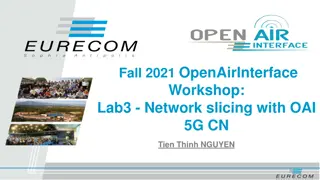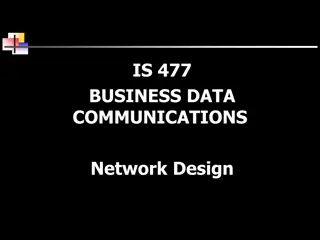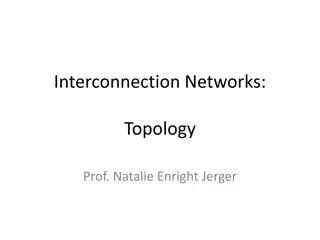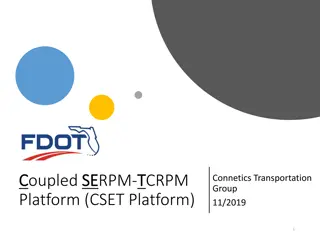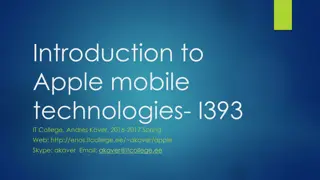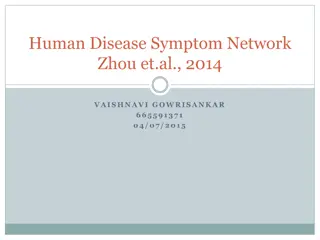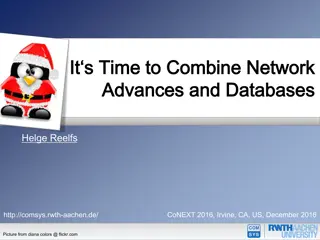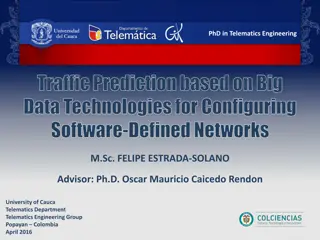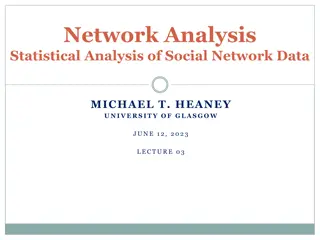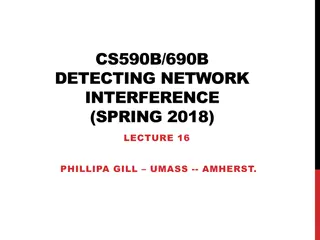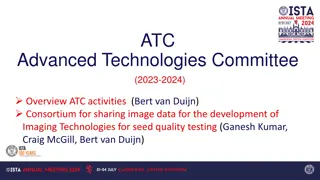Network Concepts and Technologies for Beginners
Enhance your knowledge of computer networks, internet, and network hardware with this insightful content. Explore basic vocabulary, network connections, protocols, LAN, WAN, bandwidth, cryptography, and more. Get ready to dive into the world of networking!
Download Presentation

Please find below an Image/Link to download the presentation.
The content on the website is provided AS IS for your information and personal use only. It may not be sold, licensed, or shared on other websites without obtaining consent from the author.If you encounter any issues during the download, it is possible that the publisher has removed the file from their server.
You are allowed to download the files provided on this website for personal or commercial use, subject to the condition that they are used lawfully. All files are the property of their respective owners.
The content on the website is provided AS IS for your information and personal use only. It may not be sold, licensed, or shared on other websites without obtaining consent from the author.
E N D
Presentation Transcript
Mesleki ngilizce - Technical English II Prof. Dr. Nizamettin AYDIN naydin@yildiz.edu.tr http://www.yildiz.edu.tr/~naydin 1
Notes: In the slides, texts enclosed by curly parenthesis, { }, are examples. texts enclosed by square parenthesis, [ ], are explanations related to examples. 2
Networks Learning Objectives to acquire basic vocabulary related to network concepts to become familiar with different technologies to understanding, the limits, capabilities, and benefits of specific network hardware Sub-areas covered Computer networks Internet 3
Networks Keywords Connection In networking, a connection refers to pieces of related information that are transferred through a network Packet A packet is the most basic unit that is transferred over a network. When communicating over a network, packets are the envelopes that carry your data from one end point to the other Network Interface A network interface can refer to any kind of software interface to networking hardware 4
Networks Keywords LAN stands for "local area network". refers to a network or a portion of a network that is not publicly accessible to the greater internet WAN stands for "wide area network". means a network that is much more extensive than a LAN. Protocol a set of rules and standards that basically define a language that devices can use to communicate. There are a great number of protocols in use extensively in networking, and they are often implemented in different layers. 5
Networks Keywords Bandwidth the amount of data that can be carried from one point to another in a given time period Topology The physical layout of a network Cryptography the study of encryption and decryption. 6
Networks Reading text Pre-reading questions What is a protocol? Which device forwards packets between networks by processing the routing information included in the packet? What is called the physical or logical arrangement of network? Which data communication system spans states, countries, or the whole world? 7
Networks-Introduction Comparing a data network to a living organism, the hardware provides the skeleton or basic infrastructure upon which the nervous system is built. Similarly, a few hundred meters of cable running through the walls of a laboratory is necessary but insufficient to constitute a network. Rather, the data pulsing through cables or other media in a coordinated fashion define a network. 8
Networks-Introduction This coordination is provided by electronics that connect workstations and shared computer peripherals with the networks amplify, route, filter, block, and translate data. An informatics researcher should have a basic understanding of the limits, capabilities, and benefits of specific network hardware, to be able to converse intelligently with hardware vendors to direct the management of an information services provider. 9
Networks-Introduction The Internet was a natural successor to the cold war projects in the 1950s and early 1960s The modern Internet was the unintended outcome of two early complex systems: the ARPANET (Advanced Research Project Agency Network) the SAGE system (semiautomatic ground environment), developed for the military in the early 1950s and 1960s, respectively. 10
Networks-Introduction SAGE was the national air defense system comprised of an elaborate, ad hoc network of incompatible command and control computers, early warning radar systems, weather centers, air traffic control centers, ships, planes, weapons systems. 11
Networks-Introduction The communications network component of the SAGE system was comprehensive and extended beyond the border of the U.S. and included ships and aircraft. It was primarily a military system, with a civil defense link as its only tie with civilian communications system. In the 1950s and 1960s, federally funded researchers at academic institutions explored ways to manage the growing store of digital data amid the increasingly complex network of computers and networks. One development was hypertext, a cross-referencing scheme, where a word in one document is linked to a word in the same or a different document. 12
Networks-Introduction Around the time the ARPANET was born, a number of academic researchers began experimenting with computer-based systems that used hypertext. For example, in the early 1970s, a team at Carnegie- Mellon University developed ZOG, a hypertext-based system that was eventually installed on a U.S. aircraft carrier. ZOG was a reference application that provided the crew with online documentation that was richly cross-linked to improve speed and efficiency of locating data relevant to operating shipboard equipment. 13
Networks-Introduction In addition to applications for the military, a variety of commercial, hypertext-based document management systems were spun out of academia and commercial laboratories, such as the Owl Guide hypertext program from the University of Kent, England, and the Notecards system from Xerox PARC in California. Both of these systems were essentially stand-alone equivalents of a modern Web browser, but based on proprietary document formats with content limited to what could be stored on a hard drive or local area network (LAN). In this circuitous way, out of the quest for national security through an indestructible communications network, the modern Internet was born. 14
Networks-Example Microarray Laboratory Network 15
Networks-Example The computers in a typical microarray laboratory present a mixture of data formats, operating systems, processing capabilities. The network in this example (a wired and wireless local area network) supports the microarray laboratory processes, from experimental design and array fabrication to expression analysis and publishing of results. 16
Networks A network architecture should be examined from the perspective of: Geographical scope Underlying model or models used to implement the network Signal transmission technology Bandwidth or speed Physical layout or topology Protocol or standards used to define how signals are handled by the network Ownership or funding source involved in network development Hardware, including cables, wires, and other media used to provide the information conduit from one device to the next Content carried by the network 17
Networks Network Taxonomy 18
Networks There are multiple networking Technologies: Personal Area Network (PAN) Local Area Network (LAN) Metropolitan Area Network (MAN) Wide Area Network (WAN) Storage Area Network (SAN) Enterprise private network (EPN) Virtual private network (VPN) Global Area Network (GAN) Wireless Local Area Network (WLAN) Controller Area Network (CAN) Internet Area Network (IAN) 19
Networks Geographical Scope The geographical extent of a network is significant because it affects bandwidth, security, response time, the type of computing possible. For example, it is only because of the high-speed Internet backbone that real-time teleconferencing and model sharing are possible on a worldwide basis. 20
Networks Informatics R&D incorporates network resources on worldwide (WAN), institution-wide (MAN), and laboratory-wide (LAN and PAN) levels. 21
Networks PAN personal area network a computer network used for communication among computer devices, including telephones, personal digital assistants, limited to the immediate proximity of the user, or about a 10-meter radius, If PAN is constructed using wireless technology, known as wireless personal area network (WPAN) 22
Networks PAN 23
Networks LAN local area network a network that is restricted to smaller physical areas extend to about 100-meters from a central server, or a single floor in a typical research building. e.g. a local office, school, or house. Approximately all current LANs whether wired or wireless are based on Ethernet. Data transfer speeds can extend to 10.0 Mbps (Ethernet network) 1.0 Gbps (Gigabit ethernet) Coaxial cable and CAT 5 cables are normally used for connection. 24
Networks LAN 25
Networks MAN Metropolitan Area Network take over where LANs leave off, covering entire buildings and extending tens of kilometers. typically implemented with digital subscriber line (DSL), cable modem, and fixed wireless technologies. Several LANs are often connected to make a MAN. When this configuration is used for a college campus, it is referred to as a campus area network (CAN). 26
Networks MAN 27
Networks WAN Wide Area Network connects computers together over large physical distances, such as entire country or entire world typically composed of a combination of terrestrial fixed satellite systems, coaxial cable, and fiber optical cable. The public switched telephone network and the Internet are examples of WANs. 28
Networks WAN 29
Networks SAN Storage area network connects servers directly to devices to store data moves storage resources off the common user network and reorganizes them into an independent, high-performance network. So, each server is allowed to access shared storage. This can involve Fibre-channel connection, similar to Ethernet, to handle high-performance disk storage for application. 30
Networks SAN 31
Networks EPN Enterprise Private Network a computer network built to share computer resources among different sites such as production sites, offices and shops of a business Some of the advantages of an EPN: The messages are secure because they are encrypted. They are cost effective and scalable. They help to centralize IT resources. They enable business continuity. 32
Networks EPN 33
Networks VPN Virtual Private Network an extended private network which spreads over the internet. Users can send and receive data across shared or public networks. It uses public wires usually the internet to connect to a private network usually a company s private network. The benefit of a secure VPN is its level of security to the connected systems, whereas the other network infrastructure alone can not provide it. 34
Networks VPN 35
Networks GAN Global Area Network a network composed of different interconnected networks that cover an unlimited geographical area. The term is loosely synonymous with Internet, which is considered a global area network. BGAN Broadband Global Area Network a mobile communications system created to transmit broadband wireless voice and data communications almost anywhere on the earth's surface. The system, developed by Immarsat, Inc., consists of a constellation of geostationary satellites working in conjunction with portable, lightweight, surface-based terminals about the size of a laptop. 36
Networks WLAN Wireless Local Area Network a wireless computer network that links two or more devices using a wireless distribution method within a limited area such as a home, school, computer laboratory, or office building. sometimes called a local area wireless network (LAWN) The IEEE 802.11 group of standards specify the technologies forWLANs 37
Networks WLAN 38
Networks CAN Controller Area Network a serial bus network of microcontrollers that connects devices, sensors and actuators in a system or sub-system for real-time control applications. Bosch originally developed the CAN in 1985 for in- vehicle networks Lifts and escalators use embedded CAN networks Hospitals use the CANopen protocol to link lift devices, such as panels, controllers, doors, and light barriers, to each other and control them. 39
Networks CAN 40
Networks IAN Internet Area Network a concept for a communications network that connects voice and data end-points within a cloud environment over IP, replacing an existing LAN, WAN or the public switched telephone network (PSTN). Cloud based IT & Communications interface 41
Communications Models In the traditional client-server model, a server provides data to one or more clients. In contrast, in a peer-to-peer network, every computer acts as a server and client to other computers on the network. As such, a particular computer might function as a server one moment and as a client the next The simplest type of computer network to construct in a small workgroup is a peer-to- peer network. 42
Communications Models The disadvantages of the peer-to-peer model Uneven use of resources, the workstations with the most relevant content are accessed more often than workstations with less frequently accessed content. The result is decreased performance for computational tasks of the frequently accessed workstations. Data management is more challenging. Everyone in the workgroup must perform tasks such as archiving and updating antiviral utilities, for example. 44
Communications Models A client-server model employs a central server to provide programs and data files that can be accessed by client workstations on the network. An advantage of this model is that the network operating system running on the server provides for security, tiered access privileges, and no degradation of individual workstation performance because files are accessed from the server. In addition, the data and programs on the central server can be more easily and consistently archived, backed up, accessed, and shared. 45
Transmissions Technology Switched Communications A fixed, continuous bi-directional connection is established between the message source and recipient. 46
Transmissions Technology Packet Communications Multiple, virtual communications channels are established by breaking up messages into small packets and reassembling them at the destination 47
Protocols Network protocols formal standards and policies comprised of rules, procedures and formats that define communication between two or more devices over a network. govern the end-to-end processes of timely, secure and managed data or network communication. The key standards organizations that define or suggest network protocols: the Open Systems Interconnection (OSI) group, the Institute of Electrical and Electronics Engineers (IEEE), the Consultative Committee on International Telegraphy and Telephony International Telecommunications Union-Telecommunications Sector the American National Standards Institute (ANSI), the Exchange Carriers Standards Association (ECSA), the Alliance for Telecommunications Industry Solutions (ATIS) OSI, begun by the International Organization for Standardization in the late 1970s, defines high-level communications architectures, including the OSI Reference Model 48
Protocols The OSI Reference Model OSI defines the communications process into seven different categories that deal with communications and network access. Layer 7 6 5 4 3 2 1 Name Application Presentation Session Transport Network Data Link Physical Focus Semantics Syntax Dialog coordination Reliable data transfer Routing and relaying Technology-specific transfer Physical connections The IEEE develops standards for the entire computing industry, including wired and wireless networks these standards define specific low-level functionality, such as operating frequency, bandwidth, message format, signal voltage, and connector style for computer networks. For example, the IEEE-802.3 10BaseT standard defines Ethernet over ordinary twisted pair cable 49
Key Network Protocols The most important IEEE standards in biomedical informatics: Standard Description IEEE 488 Computer to electronic instrument communications; also known as GPIB and HPIB IEEE-802 LAN and MAN standards IEEE-802.3 Ethernet; the most common LAN specification IEEE-802.3 10Base-T Ethernet over twisted pair cable IEEE-802.11 Wireless LANs IEEE-802.11a 5 GHz, 54 Mbps wireless LAN; shorter range than 2.4 GHz systems, higher bandwidth, and more channels than WiFi IEEE-802.11b 2.4 GHz, 11 Mbps wireless LAN; the most common, most mature; limited channels, also known as WiFi 50





